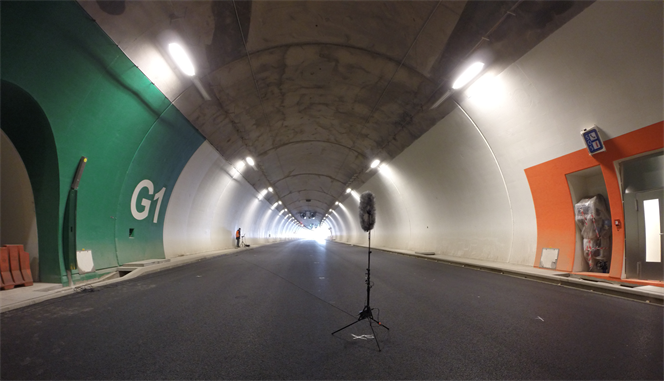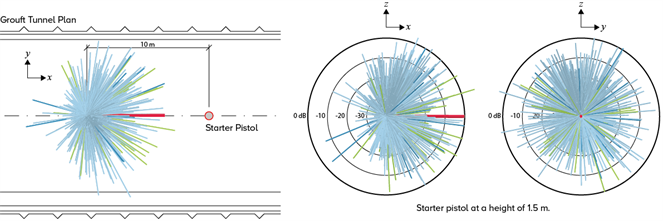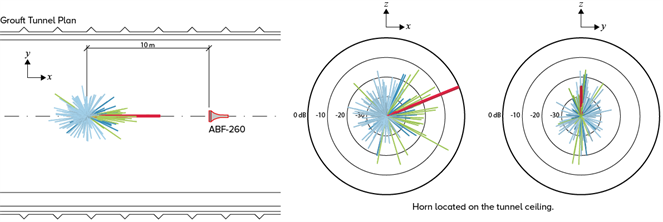Tunnel Announcement System
The IRIS 3D acoustic impulse response measurement and visualisation system was used by
Duran Audio to assess the performance of their ABF-260 horn installed in a road traffic tunnel.
Background
Voice warning and announcement systems are often required to be installed in road traffic tunnels. These environments are typically highly reverberant with high levels of background noise, which present a challenge for transmitting speech sounds intelligibly.
Duran Audio developed the ABF-260 horn specifically for this purpose. It is intended to be mounted on the ceiling of a tunnel and projects sound along the length of the tunnel and downwards, with very little to the sides. This results in a higher direct-to-reverberant ratio than a simple loudspeaker, and therefore greater speech intelligibility.
Application
To illustrate this performance, Duran Audio used IRIS to conduct several 3D impulse response measurements in the Grouft Tunnel in Luxembourg (Fig. 1), where a number of ABF-260 horns are installed as part of the evacuation system.

Fig. 1: The IRIS microphone set up inside the Grouft Tunnel in Luxembourg, with the ABF-260 visible in the distance (small grey rectangle above the fans)
At each receiver position, the horn system was compared to a starter pistol (i.e. an omnidirectional source). The horn system was excited with a logarithmically swept sine wave signal. The broadband results for a receiver positioned 10 m horizontally from the source and 1.5 m above the road are shown in Figs. 2 and 3.

Fig 2: The broadband IRIS diagrams for the starter pistol source (Click to view larger image)

Fig. 3: The broadband IRIS diagrams for the ABF-260 horn source (Click to view larger image)
 The IRIS diagrams show sound rays arriving at the receiver position as 3D vectors. The length of each vector indicates level, the angle is the direction, and colour corresponds to the time of arrival (see key). The broadband direct sound is represented by the red vector and assigned a level of 0 dB. The remaining vectors correspond to subsequent reflections with magnitudes greater than -40 dB.
The IRIS diagrams show sound rays arriving at the receiver position as 3D vectors. The length of each vector indicates level, the angle is the direction, and colour corresponds to the time of arrival (see key). The broadband direct sound is represented by the red vector and assigned a level of 0 dB. The remaining vectors correspond to subsequent reflections with magnitudes greater than -40 dB.
The starter pistol diagrams (Fig. 2) show very strong reflections arriving from every direction except from the open end of the tunnel. The circular cross section of the tunnel causes focusing, evident by some reflections being larger in magnitude than the direct sound.
The results using the horn system are remarkably improved (Fig. 3). There is considerably less reflected energy compared to the starter pistol measurements, with very little energy arriving from the sides (see Y-Z view in Fig. 3). The direct sound is larger in magnitude than subsequent reflections, meaning an improved direct-to-reverberant ratio. The difference can be appreciated in the change in value of D50 (the early-to-total sound energy ratio) – 0.3 was measured with the pistol source, and 0.74 with the horn system (2 kHz 1/3 octave band).
Duran Audio found IRIS to be an easy to use and efficient tool, ideally suited to a time-critical measuring environment.
For more information about Duran Audio visit www.duran-audio.com. Further technical details of the ABF-260 horn can be found in the paper: Design of voice alarm systems for traffic tunnels: optimisation of speech intelligibility by Evert Start.
What people are saying
-
The success of a musical performance depends on the sense of proximity of performer to listener. This sense is mediated largely by the directional properties of the reflected sound field.
Sir Harold Marshall -
The operation and configuration of IRIS is effortless...
Sebastià V. Amengual Garí -
I regard the acoustic designs of Marshall Day Acoustics to be amongst the finest and probably the most innovative in the world.
Dr Anders Gade, Technical University of Denmark